By Pete Vack

|
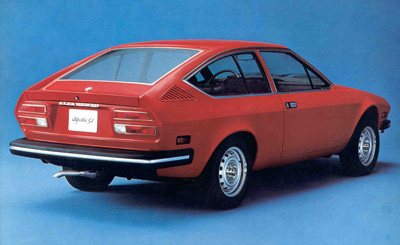 The Alfetta GT by Giugiaro was a worthy successor to the Bertone GTV
and as fresh today as it was in 1974.
The Alfetta GT by Giugiaro was a worthy successor to the Bertone GTV
and as fresh today as it was in 1974.
|
The Alfetta Sedan and GT
The Alfetta series—which are roughly defined herein as any of the front engined,de Dion transaxle cars made from 1973 to 1992, were created to replace the existing solid axle Alfas, and to significantly improve the highly praised handling characteristics of the Alfas produced up to that point.

|
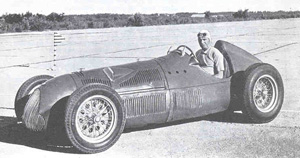 The famous Alfetta Grand Prix car, which gave its name to the new series
of transaxled Alfas in the 1970s. The Alfettas were victorious from 1946 to
1951, when they retired the car from competition.
The famous Alfetta Grand Prix car, which gave its name to the new series
of transaxled Alfas in the 1970s. The Alfettas were victorious from 1946 to
1951, when they retired the car from competition.
|
Noteworthy in this era of Retrocars, the Alfetta took its name from the famous 158/159 Alfa Romeo Grand Prix cars, raced from 1939 to 1951. These unbeatable race cars featured a similar transaxle layout, and were called the small Alfa, or Alfetta, because of the 1500cc displacement. However, a major difference was that the Grand Prix car left the clutch at the engine end, a difference that as we shall see, meant a great deal.

|
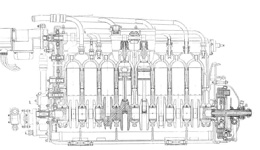 A cross section of the Alfetta Grand Prix engine--1500cc supercharged
straight eight. But note where the clutch is--still on the engine flywheel.
A cross section of the Alfetta Grand Prix engine--1500cc supercharged
straight eight. But note where the clutch is--still on the engine flywheel.
|
The Alfetta was conceived under the technical direction of Rudolph Hruska, who had been recalled by Alfa to replace the great Dr. Orazio Satta Puliga. In every way, the conception, the idea, the dream of the new Alfetta was thoroughly commendable, and held great promise.
On paper, there was little to fault. Here was a car with the traditional 2 liter four, (2000 cc for the US market, and available in both 1.8 and 1.6 versions in Europe) now producing about 140 hp, with a completely new chassis, four wheel independent suspension, a de Dion rear axle with a inboard disc brakes and the clutch integral with the transmission. The combination meant a 50-50 weight distribution, less unsprung weight,
no axle tramp, and excellent handling characteristics for both road and track.

|
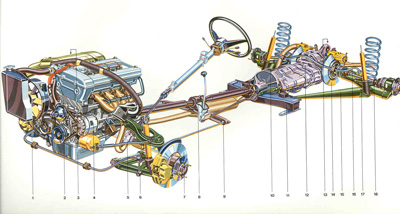 A fantastic idea in concept, but keeping that long driveshaft vibration free
as it turned at engine speed was difficult to achieve. However, the 50-50
weight distribution made the Alfettas and their successors a joy to drive.
A fantastic idea in concept, but keeping that long driveshaft vibration free
as it turned at engine speed was difficult to achieve. However, the 50-50
weight distribution made the Alfettas and their successors a joy to drive.
|
The in-house designed Alfetta 1.8 sedan, first seen in May of 1972, was a refreshing change from the previous and bulky 2000 Berlina, with modern instrumentation, plenty of greenhouse, and more interior room despite a shorter wheelbase. It was truly a sedan that could handle, and accomodate five
people with both ease and comfort. Even with the 1800 cc version, performance
was more than adequate, and at the time, one of the hottest sedans
on the market.

|
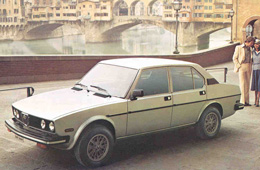 The name Alfetta was dropped and replaced with the more mundane nomenclature of Alfa Sport Sedan. It was the first Alfa to be offered with an automatic tranmission.
The name Alfetta was dropped and replaced with the more mundane nomenclature of Alfa Sport Sedan. It was the first Alfa to be offered with an automatic tranmission.
|
But that was nothing compared to the Alfetta GT 1.8, which was designed by Giugiario and introduced to the press in June 1974. The design has held and today it is as attractive as it was in the early 1970s. Plus the Cd factor was an excellent 0.39. It was a successful attempt to replace the classic Bertone Sprint coupe, a very mean feat. The interior could be described as ultra modern, and Alfa placed the tachometer directly in front of the driver, with the speedometer in the center, a purposeful snub to the new US 55 mph speedlimit. The Alfetta GT had charm, engineering, beauty and class.
Nevertheless, the attempt to maintain a reliable and vibration free drivetrain was valiant but to a large degree, in vain. In the mid 1960s, starting with the 275GTB, Ferrari also decided to place the clutch and transmission with the rear axle. Despite a lot of development time, superb quality and engineering, the problems associated with the driveshaft turning at engine speed were never fully resolved, despite the use of an enclosed torque tube and eventually, a full integrated solid drivetrain from stem to stern. Years later, however, Ferrari tried it again with the 456 GT, which also used a transaxle layout and enhanced for the 612 Scaglietti.
That Alfa would be able to solve the same problems on a mass production basis was unlikely. During the development stage, the prototypes had constant vibration maladies, in addition to headaches with the long distance gearchange, delaying the introduction of the Alfetta by almost a year.
The first production Alfettas lacked the quality of previous Alfas. Seats became unstitched, switches broke, dash pods literally melted in the noonday sun, and glovebox covers warped.
Where body rust had once been limited to wheelarches and rockers, within months from new it now appeared around the front and rear windows, the front shock mounts, the edge of the fenders, and other gruesome places one never bothered to look.

|
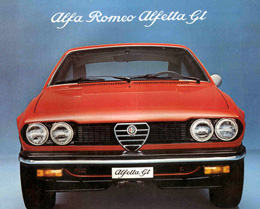 Alfa's always did lean a little, didn't they?
Alfa's always did lean a little, didn't they?
|
Even though most of the problems with the gearshift linkage were worked out, gone was the golden wand of the earlier five speed cars, which the gearlever directly attached to the transmission. This was much lamentable.
Fortunately, things got better. With each model, the cars were improved in every respect. Ironically, the Alfetta name was dropped. Consumers in the US
new nothing of the Alfetta 158/159s, and in Europe, Alfetta meant 'small' Alfa,
which was not a positive term. The world was changing, and in 1986, Alfa even offered (and pushed) the first automatic transmission in an Alfa Romeo, on the Sport Sedan, primarily because it made for a much smoother, long lasting drivetrain.
It was not a success, but Alfa had another trick for the ailing Alfetta GT, and that was to install the new V-6. This made a totally different animal out of the Giugiaro coupe. By the time the Milano was introduced in late 1986, it was hard to tell that the car had a driveshaft turning at engine speed, and the quality was further improved. It seemed as though Alfa had finally gotten its act together. But the Milano and its smaller European counterpart the Giulietta,
would truly be the last of the real Alfa Romeos.
Next---driving an immaculate Alfa GTV6 coupe.



